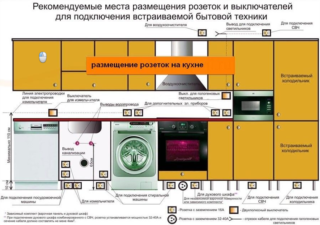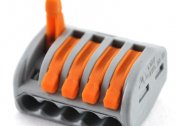When installing powerful kitchen equipment (oven, hob), you must follow the principles of its safe connection - use special consumables and accessories for wiring electricians. One of the important elements is the outlet for the oven. If you ignore this norm, household appliances will not last long.
What sockets are needed for powerful equipment

The cable and outlet for the oven should be selected according to the power of the device. It is usually indicated in the technical documentation for the equipment. Basically, ovens operate at a voltage of 220/380 V. The current strength here is 25/32 A. It all depends on whether the equipment is single-phase in front of the master or three-phase.
More often, under powerful cabinets they use such sockets for a stove and oven:
- At 16 A and 220 V. Designed for standard household appliances with power up to 3.5 kW.
- At 32A / 220 V. Used with single-phase ovens with a power of 3.6-7 kW.
- At 20 A / 380 V. Designed for three-phase technology.
All power points to powerful equipment are grounded. Therefore, they have more terminals than standard elements. For single-phase outlets, two power points and one ground are provided. Three-phase ones have 3 power supplies, one for grounding, one for zero (total 5).
Possibility to connect the oven to a conventional outlet
It is not recommended to connect the oven to a conventional outlet. It has been established by fire safety standards that separate power lines must be installed for powerful kitchen appliances. This is due to the fact that the oven, frying equipment consumes more power than standard appliances: washing machine, hairdryer, kettle, etc. If you do not make a separate line, the machine will constantly operate in the house or an emergency occurs due to melting / fire of weaker wiring .
The exception is ovens up to 3.5 kW. They can work from a standard outlet.
Power Point Locations
 The outlet for the oven cannot be installed in the following areas of the kitchen, in accordance with established standards:
The outlet for the oven cannot be installed in the following areas of the kitchen, in accordance with established standards:
- on the wall in close proximity to hot equipment;
- in the area of wet objects: washing, draining, water pipes;
- at height, much more than the working surface;
- near gas pipes - sockets are removed from them by at least 40 cm;
- in close proximity to the floor - it is advisable to raise the feeding point 15-20 cm from its level, ideally - 100 cm.
A good area for setting the power point is the wall under the countertop - under the built-in furniture. Access to the outlet in this case is always open, and the zone of its location remains dry. Connecting the plug to a power outlet is very simple here.
Masters recommend that you refrain from deciding to make an outlet behind the oven. The feeding point should be located in a dry place accessible to the eye of the hostess. It should not be affected by temperature extremes. And in any case, it is inevitable when the cabinet is working.
Another point to consider is the operation of the combi steamer (steam supply to industrial plants). Even in small quantities, condensate can settle on the outlet located behind the appliance. This is an assumption of an emergency.
The power point, installed immediately behind the cabinet, can prevent it from integrating organically into the overall “ensemble” of the kitchen. The equipment will be unsightly going beyond one common line with the furniture.
Power determination
Power is the main parameter that determines the choice of outlet, which you can connect to later when installing the oven. To calculate it, you need to divide the amount of power consumed by the equipment (for example 3.5 kW) by the network voltage. Typically, the master receives a value of 16, 20 or 32 A. This indicator socket allows you to safely install, connect and operate the oven.
Options to consider
When connecting the oven and hob to the mains, it is important to pay attention to the type of appliance plug. More often it is presented in the European standard. Therefore, the outlet must be bought from the same class. Otherwise, the money will be wasted.
Additionally, it is desirable to pay attention to the material of the insides of the outlet. It is better if it is ceramic, not aluminum components. Only under such conditions the power point will withstand a continuous cycle of the equipment for 2-3 hours (standard mode for wind equipment).
In order to de-energize the kitchen as quickly as possible in an emergency, it is better to provide automatic machines for 32 A.
Socket installation diagrams
Connecting the power point can be done in the following ways:
- Outdoor installation. Provides for the use of a wall outlet. Openly mount power points without fail on wooden walls. This is regulated by the PUE. It is forbidden to cut both wiring and sockets into a tree. For concrete, brick, gas blocks, an open installation method is at the discretion of the master, if this fits into the general concept of the interior of the kitchen.
- Hidden way. Assumes insertion of the outlet into the wall. This method is often used when performing major repairs in the kitchen or before finishing, because the work is rather dirty. You have to pretty much damage the tiled kitchen apron. However, for a master with experience, this is not a problem.
From the point of view of fire safety, an open method of installing outlets is preferable. In addition, they can be easily integrated into kitchen cabinets or a table.
Possible mistakes
Sometimes masters allow such flaws when installing sockets under the oven:
- Lay a separate wire, grounding the power point on pipes and risers. It is life threatening.
- Other household kitchen appliances are connected to the oven power circuit. This provokes emergency situations.
- Three-phase models of equipment are connected to a single-phase line of electricians. Part of the cooking hobs will be blocked, and their indicators will show the remaining heat.
To choose the right outlet for the oven, you must initially familiarize yourself with the technical documentation for it. To connect both the hob and the oven, you cannot use a double combo socket. A separate powerful cable is pulled under each type of equipment. If both types of equipment will be on the same supply line, this will lead to the operation of the machine.
In new buildings, the issue of bringing power lines under the kitchen electrician is already provided. Therefore, it is easier for the master to connect with their own hands.



